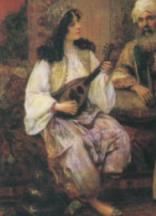About Ouds and Other String Instruments
The information below is what appeared on our old oud pages please note that the information is currently being expanded and revised. Some of the information below may not be accurate or may be outdated. Please be sure to check back at another time for the new content.
The oud is the ancient ancestor of the modern day guitar. It is very similar to the European Lute, which also evolved from this instrument after having been introduced to Europeans by crusaders returning home from the Middle East. It is a short necked, pear shaped instrument and is played by plucking the strings much like a guitar. Ouds vary slightly from different regions. Depending on where it is from it may have 9 strings or it may have more. It is generally an odd number of strings because there are a number of sets of stings and then a single string by itself. There are variations on that as well as the tuning sequence based on type of oud and region. An oud is made of wood and is sometimes highly decorated with things like a mother of pearl inlay. You may also find it spelled Ud. If you already know how to play a guitar this will be fairly easy to learn to play. However this is a fretless instrument so you will have to learn a different technique be able to play it properly. Here is an example of an Oud.
This example is from the CD Music of the Near East: The Oud by Aram Gulezyan. The clip is titled Pharaonic Egyptian.
Here is another clip of an oud (I do not know where it's from or who it's by though:
Click play to listen to the Oud


